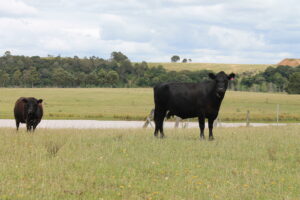Increased feeder cattle availability and lower prices have been enough to offset the increase of other inputs for lotfeeders, with cattle on feed numbers climbing higher in the September quarter.
The modest increase of about 1500 head took the number of cattle on feed to 1.258 million head, making the July to September 2023 period the second-highest number recorded. Capacity and utilisation figures were also strong, with exports of grainfed beef their best yet, all of which indicates plenty of positivity for the sector.
Starting with the cattle going onto feed, numbers in Victoria and WA declined by 4% and 40% (not seasonally uncommon) respectively in quarter three, according to the latest Meat and Livestock Australia and Australian Lot Feeders Association lotfeeding brief. Making up for this was an increase of 2% in Queensland, up about 26,000 head on the previous quarter, and increasing by close to 150,000 head on the same quarter last year, making it a record number for the state.
Capacity reached its highest ever level last quarter, at 1.57 million head, with 80% of this being utilised, which was pretty on par with the previous (June) quarter. However, this utilisation was up 10% year-on-year and was about 1% higher than the five-year average. When it comes to inputs, MLA reported the feeder steer indicator was 42% lower year-on-year for the quarter, and yardings were up 23% for the same period. On the other hand, wheat – meaning feed – prices have been on the increase since the start of the year, and rose another 8% for the quarter, making it $49/tonne dearer than the same time last year.
Turn-off also assisted with the increase in numbers, falling by 10% for the quarter to about 618,000 head, making it the lowest turnoff of any quarter since the December 2013 period. This was a decrease of about 95,000 head year-on-year for the September quarter and emphasises the trend of cattle staying on feed longer. Two contributors to this are reports of the heavy feeder category cattle being harder to come by due to the tighter season – and the lighter ones no doubt being cheaper – as well as gaining the most profit margin out the other end both by increasing weights and perhaps the gamble that beef prices will also improve.
Demand for the final product was also on the up for the quarter, with grainfed exports up 10% to record levels and the three top markets, Japan, South Korea, and China, all increasing their intake.
What does it mean?
While lot feeders have been benefiting from the falling young cattle prices, they’ve also been facing plenty of other rising costs this season, as well as lower finished cattle prices themselves. Lower turnoff numbers well outweigh the higher number of total cattle of feed, showing they were less active for the quarter than those numbers might demonstrate.
Record high capacity and strong utilisation, teamed with the record high grainfed beef exports, all demonstrate a growing sector that is confident of progression despite the extremities of the market in the past 12 months.
Have any questions or comments?
Key Points
- After slightly rising last quarter, cattle on feed numbers are now at their second-highest number on record.
- Australia’s grainfed beef exports also rose, reaching record volumes for the July to September period.
- Lotfeeding capacity increased for quarter three, and utilisation held fairly steady, down by just 1%.
Click on figure to expand
Click on figure to expand
Data sources: MLA, ALFA, Mecardo














